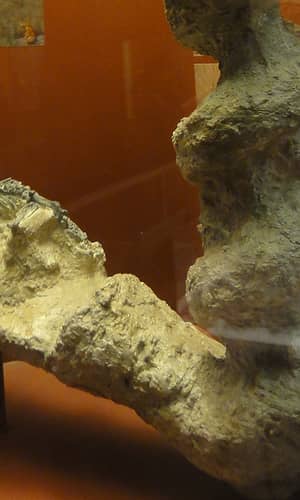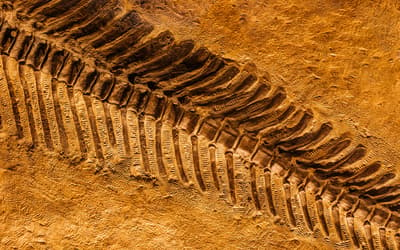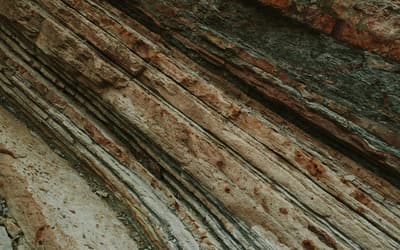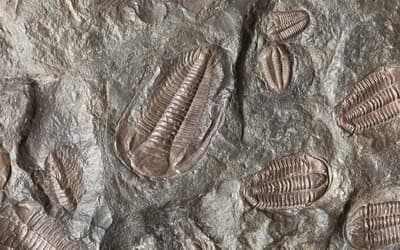The views expressed in this paper are those of the writer(s) and are not necessarily those of the ARJ Editor or Answers in Genesis.
Abstract
A peculiar ichnofossil found in western North America is described for its potential as a biostratigraphic marker in Flood models. The now-extinct burrowing beaver Palaeocastor dug large helical burrows, preserved as fossil daimonelices. Their unique manner of preservation provides a means of evaluating whether they were formed before, during, or after the Flood.
Keywords: Biostratigraphy, Daimonelix, Flood Boundary, Fossils, Ichnofossils, Miocene, Palaeocastor
Introduction
Whitmore and Garner (2008) proposed suites of criteria that might be used to identify strata as from the pre-Flood, peri-Flood, or post-Flood period, suggesting that boundaries between such “should primarily be identified by applying suites of criteria and recognizing widespread patterns” (425). They noted that the use of “one or two particular criteria” can be problematic, as not all criteria are of equal importance and some criteria may be found within more than one period.
While this may be a good rule of thumb, it does not logically follow that we cannot ever determine the period of a rock unit or fossil site through a primary criterion. Wood (2022), for example, noted while considering Neanderthal remains, “Since any sedimentary deposits on the floor of caves must necessarily postdate the carving of the cave, and since the carving of the cave must necessarily postdate the formation of the rock into which the cave was carved, we may infer that any fossils found in the sediments on cave floors are unlikely to have formed earlier than the rock formation into which the cave was cut.” From this, he was able to infer that because caves formed during the Flood or after the Flood, Neanderthal remains found in those caves are best considered post-Flood.
A remarkable Cenozoic ichnofossil (trace fossil) from western North America has the potential to act as an individual biostratigraphic marker at any location where it is found (Arment 2021). At the very least, it needs to be considered seriously by anyone evaluating the Flood Boundary debate as it applies to North America.
Daimonelix
In 1891, Dr. Erwin Hinckley Barbour examined a number of extremely large spiral-shaped fossils in northwestern Nebraska (Barbour 1892). Local ranchers referred to them as “screws,” “twisters,” or “Devil’s corkscrews” (Barbour 1896). These vertically upright spiral coils reach almost 2.75m (9ft) in height, and terminate in a somewhat horizontal but sloping tube that can reach about 4.5m (14.75ft) in length (Martin and Bennett 1977). The highest concentration resides in the Harrison Formation of western Nebraska and eastern Wyoming (Martin and Bennett 1977). The Harrison Formation is characterized in the secular model as earliest Miocene in the Oligocene-Miocene Arikaree Group, supported by mammalian biochronology and argon-argon dating at Agate National Monument (Hunt 2005). Barbour (1892) initially examined a great number of these fossils covering an area of several square miles. He later noted, “Some four or five hundred square miles characterized by such topography have been explored, even into Wyoming, and Daemonelix is found to be an ever present and striking feature” (Barbour 1896, 306).
Barbour named these fossils Daimonelix (alt. Daemonelix; pl. daimonelices). After considering whether it might be a fossil bryozoan or the case of an ancient worm (Barbour 1892), he proposed that they were fossil plants with large helical roots and horizontal rhizomes (Barbour 1896), while other scientists thought they might simply be concretions. E. D. Cope and Theodor Fuchs independently arrived at the conclusion that these were rodent burrow casts, and after a few decades, this came to be widely recognized as the appropriate identification (Schultz 1942).
The genus Palaeocastor, a burrowing beaver, was responsible for these burrows, with P. fossor and P. magnus forming their own towns of prairie dog-like communities (Martin and Bennett 1977). (Ichnology, the study of trace fossils, uses a discrete classification scheme similar to zoological or botanical classification, so Daimonelix as an ichnotaxon technically can include burrows created by distinctly different organisms. For this argument, I am referring specifically to Palaeocastor burrows.) Remains of these beavers have been found in the tunnels, usually in the lower chambers which likely included nesting and habitation areas. The burrows’ paleoenvironment was open grassland, “semi-arid, upland . . . sandy substrate” (Martin and Bennett 1977, 173), where these terrestrial beavers likely grazed similar to modern-day prairie dogs. While there is no consensus over why the beavers created deep helical burrows (Doody et al. 2018), the unusual construction may have functioned to stabilize temperature and humidity (Martin and Bennett 1977; Meyer 1999).
Daimonelix Preservation
The Harrison paleosols (“ancient soils”) in which Palaeocastor burrows were dug, are characterized as volcaniclastic, containing “substantial quantities of volcanic ash” (Martin and Bennett 1977), with “undifferentiated stream and eolian deposits” (Graham 2009). Hunt (1990, 69) noted that the Arikaree was originally made up of wide shallow valleys which “first filled with fluvial fine-grained volcaniclastics, but with the cessation of streamflow in the region, filling was completed by air-fall volcaniclastic loess that blanketed both valleys and interchannel reaches.” The volcanic loess was intermittently stabilized by soil development, which can now be recognized as interbedded silcrete paleosols (MacFadden and Hunt 1998). Grassland soil can be specifically recognized by mollic epipedons (rounded clods of clayey soil), and Nebraska’s Harrison Formation is the oldest paleosol showing such (Retallack 1997).
A volcanic soil helped set the stage for optimal preservation of daimonelices in conjunction with one other factor: plant roots. Palaeocastor burrow walls were densely infiltrated by grassland plant roots throughout their entirety, as the burrow provided an optimal micro-habitat. The root mats helped stabilize the burrows (Martin and Bennett 1977). Beaver activity kept the roots in check, but if a burrow was abandoned, it was quickly infilled with roots (and this can be observed in some fossil burrows).
The volcanic soil provided a source of amorphous silica which, dissolved and in equilibrium in the ground water, was readily absorbed by the grassland root systems for deposition throughout the burrow system. As Martin and Bennett (1977, 181) noted, this process “probably resulted in a very rapid partial lithification of beaver burrow walls, perhaps within a few years of the death of the plants occupying this microhabitat. . . . Fossilization must have occurred before complete or even very extensive decay to account for the preservation of cellular detail. . . . [M]ost of the preservation of burrow structures in the Harrison Formation is due to the infilling of the walls with roots which rapidly silicified.”
Before, During, or After the Flood?
Several points need to be considered with Palaeocastor daimonelices.
- Burrows are lebensspuren (biogenic sedimentary structures) which by definition are non-transportable (Frey 1975). Fossilization had to have occurred in place. This is supported by the consistent upright position of the helical burrows in widespread colonies throughout the formation.
- Burrow formation and fossilization took place over a period of time. It took time for grassland roots to infiltrate burrow walls, and time for silicification to occur. Some burrows were completely infilled with root growth (Martin and Bennett 1977) before fossilization occurred.
- Burrows built at different levels (“staggered vertical distribution . . . through nearly 45m [150ft] of the Arikaree Group beneath the Upper Harrison beds” [Hunt 1990, 84–85]) indicate time passing and soil building up through episodic volcanic and eolian processes. As MacFadden and Hunt (1998, 152) noted, “These burrows often occur in communities that collectively establish the location of ancient land surfaces within the Harrison volcaniclastic loess, demonstrating the episodic nature of loess sedimentation over time.”
Could Palaeocastor burrows have been formed before the Flood? No, a global Flood would have destroyed these formations if they had already been formed prior to the Flood. Current Flood models (wherever they place the Flood/post-Flood boundary) would consider the Arikaree Group either Flood or post-Flood deposition.
Could Palaeocastor burrows have been formed during the Flood? The amount of time necessary for burrow formation, then plant growth and burrow infiltration, then fossilization, at multiple vertical levels, clearly disconfirms this as a possibility. There are fossil burrows in strata that all current Flood models would consider Flood deposition, such as in Montana’s mid-Cretaceous Blackleaf Formation (Varricchio, Martin, and Katsura 2007), in Utah’s Jurassic Escalante Member of the Entrada Sandstone (Loope 2006), in Utah’s Jurassic Morrison Formation (Raisanen and Hasiotis 2018), in a Triassic deposit from Poland’s Holy Cross Mountains (Talanda et al. 2011), in Antarctica’s Triassic Fremouw and Lashly Formations (Sidor, Miller, and Isbell 2008), in China’s Permian Naobaogou Formation (Liu and Li 2013), and in South Africa’s Permian Teekloof Formation in the Karoo Basin (Smith 1987). None of these peri-Flood burrows suggest anything other than that the animals that made them (sometimes found fossilized within the burrows) were just trying to escape the Flood waters by burrowing into mud or sand. None of the peri-Flood burrows demonstrate extensive root infiltration or continuous plant growth.
The Permian Karoo Basin fossil burrows, associated with the mammal-like synapsid Diictodon, do show a helical formation and have been classified as daimonelices (Smith 1987), but there are notable differences from what we see in Palaeocastor burrows. The Diictodon burrows only descended one-half to three-quarters of a meter in depth, and when found today are in broken and incomplete sections. In some cases the burrow is inferred from the position of a Diictodon skeleton: “The distinction of siltstone-filled burrows in structureless mudrock host sediments is very subtle and may only be made obvious when part or all of the infill is preferentially calcretised” (159). Impressions of rootlets have been found alongside some casts, but there is no indication of root mat growth into or within the burrows. They rather suggest post-burial cementation (with calcium carbonate) of peri-Flood burrows in Flood-deposited sediment that incorporated surrounding root matter before the roots otherwise decayed.
The physical evidence logically points to Palaeocastor burrows being a crucial component of a post-Flood ecosystem. The terrestrial beaver Palaeocastor left these fossil traces behind, and they serve as a strategic marker in interpreting the physical landscape from a biblical perspective.
Conclusion
One of the unfortunate consequences of the Flood/post-Flood boundary debate is that corresponding changes in biological diversification and biogeography to climate and landscape during the recovery period between the Flood and the Ice Age (what Wise [2002, 235] called the Arphaxadian epoch) sometimes get little consideration. Froede (1995) proposed a timeline for creationists that moves straight from the Flood into the Ice Age, which he divided into Lower, Middle, and Upper periods. Even if that Lower Ice Age period corresponds to the Arphaxadian, the terminology does not adequately address significant post-Flood diversification and biogeographic range dynamics. In any case, uniformitarian science correlates the expansion of the North American grasslands in the Late Miocene with a cooling and drying climate (Retallack 1997), and that climatic change fits well within a post-Flood global system that is moving from an immediate post-Flood environment that is warm with high precipitation, toward what would eventually become the Ice Age (Snelling 2009, 763–768).
There is little mention of Palaeocastor daimonelices in the creationist literature. Oard (2010, 91) noted that it had been argued that these burrows couldn’t have been formed during the Flood, so must be post-Flood. Oard disagreed, arguing instead that these represent “animal activity during the Flood,” on “briefly exposed diluvial sediments.” Clearly, extensive plant growth, episodic and vertically staggered burrow formation, and a large terrestrial beaver population demonstrate that this phenomenon didn’t “briefly” occur during the Flood. McClenagan (2022) referred to them in discussing the bone bed deposits at Agate Fossil Beds National Monument in Nebraska. He interpreted the Agate Fossil Beds as post-Flood deposition into channels cut within the Ogallala Formation, which he considered Flood strata based on the Clarey Flood Model (Clarey 2020). McClenagan noted that the Middle Miocene Ashfall Fossil Beds of the Ash Hollow Formation in northeast Nebraska had also been interpreted as post-Flood by Akridge and Froede (2005, 189), who suggested, “the paleoenvironment appears to have been one of broad areas of grassland punctuated with occasional trees, lakes and undergrowth. The climate would have been moderate and supportive of herds of grazers that inhabited the grassed savannas. It was during this period that the climate remained moderate in temperature but precipitation generally decreased.” Akridge and Akridge (2008) suggested that Ashfall Fossil Beds was the consequence of multiple ashfalls in a post-Flood landscape, and Akridge, Froede, and Akridge (2011, 325) continued to argue their case, noting that the Ashfall Fossil Beds’ fossils were “buried in a shallow deposit of unconsolidated ash and overlain by a paucity of other unconsolidated materials. The amount of deposition above the fossils is what would be expected in a few thousand years of subaerial activity.” They likewise noted serious problems with expecting briefly exposed Flood sediments to provide opportunity for rapid vegetation growth.
Palaeocastor’s helical burrows join several other biostratigraphic arguments exploring the fossil record’s relationship to the biblical record (Arment 2020a; 2020b; Ross 2012; 2014). As more time is spent by creationists inspecting Cenozoic fossil sites, it is the author’s hope that it brings into focus a more expansive and realistic picture of when the post-Flood world began and how it developed. Creationists should continue examining the geological and paleontological records for additional stratigraphic markers, whether from the pre-, peri-, or post-Flood periods.
References
Akridge, A. Jerry, and M. Elizabeth Akridge. 2008. “Death on the Plains of Nebraska.” Creation Research Society Quarterly 45, no. 2 (Fall): 126–133.
Akridge, A. Jerry, and Carl R. Froede, Jr. 2005. “Ashfall Fossil Beds State Park, Nebraska: A Post-Flood/Ice Age Paleoenvironment.” Creation Research Society Quarterly 42, no. 3 (December): 183–192.
Akridge, A. Jerry, Carl R. Froede, Jr., and M. Elizabeth Akridge. 2011. “Response to Michael Oard’s Article Questioning our Post-Flood Interpretation of the Fossil Animals Identified at Ashfall Fossil Beds State Historical Park, Nebraska.” Creation Research Society Quarterly 47, no. 4 (Spring): 324–327.
Arment, Chad. 2020a. “To the Ark, and Back Again? Using the Marsupial Fossil Record to Investigate the Post-Flood Boundary.” Answers Research Journal 13 (April 8): 1–22. https://assets.answersresearchjournal.org/doc/v13/ark_fossil_record_post-flood_boundary.pdf.
Arment, Chad. 2020b. “Implications of Creation Biology for a Neogene-Quaternary Flood/Post-Flood Boundary.” Answers Research Journal 13 (November 4): 241–256. https://answersresearchjournal.org/neogene-quaternary-flood-boundary/.
Arment, Chad. 2021. “Fossil Corkscrews After the Flood.” ZooCreation. http://www.zoocreation.com/fossil-corkscrews.
Barbour, Irwin. [sic] H. 1892. “Notice of New Gigantic Fossils.” Science 19(472) (February 19): 99–100.
Barbour, Erwin Hinkley. 1896. “Nature, Structure, and Phylogeny of Daemonelix.” Bulletin of the Geological Society of America 8, no. 1 (January 1): 305–314.
Clarey, Timothy. 2020. Carved in Stone: Geological Evidence of the Worldwide Flood. Dallas, Texas: Institute for Creation Research.
Doody, J. Sean, Colin R. McHenry, Mike Brown, Gordon Canning, Gary Vas, and Simon Clulow. 2018. “Deep, Helical, Communal Nesting and Emergence in the Sand Monitor: Ecology Informing Paleoecology?” Journal of Zoology 305, no. 2 (February): 88–95.
Frey, Robert W. 1975. “The Realm of Ichnology, Its Strengths and Limitations.” In: The Study of Trace Fossils, edited by Robert W. Frey, 13–37. Berlin, Germany: Springer-Verlag.
Froede, Carl R. Jr. 1995. “A Proposal for a Creationist Geological Timescale.” Creation Research Society Quarterly 32, no. 2 (September): 90–94.
Hunt, Robert M. Jr. 1990. “Taphonomy and Sedimentology of Arikaree (Lower Miocene) Fluvial, Eolian, and Lacustrine Paleoenvironments, Nebraska and Wyoming; A Paleobiota Entombed in Fine-Grained Volcaniclastic Rocks.” In: Volcanism and Fossil Biotas, edited by Martin G. Lockley, and Alan Rice, 69–111. Boulder, Colorado: Geological Society of America Special Paper 244.
Hunt, Robert M. Jr. 2005. “An Early Miocene Dome-Skulled Chalicothere from the ‘Arikaree’ Conglomerates of Darton: Calibrating the Ages of High Plains Paleovalleys Against Rocky Mountain Tectonism.” American Museum Novitates 3486 (October 27): 1–45.
Liu, Jun, and Lu Li. 2013. “Large Tetrapod Burrows from the Permian Naobaogou Formation of the Daqingshan Area, Nei Mongol, China.” Acta Geologica Sinica (English Edition) 87, no. 6 (December): 1501–1507.
Loope, David B. 2006. “Burrows Dug by Large Vertebrates into Rain-Moistened Middle Jurassic Sand Dunes.” Journal of Geology 114, no. 6 (November): 753–762.
MacFadden, Bruce J., and Robert M. Hunt Jr. 1998. “Magnetic Polarity Stratigraphy and Correlation of the Arikaree Group, Arikareean (Late Oligocene-Early Miocene) of Northwestern Nebraska.” In: Depositional Environments, Lithostratigraphy, and Biostratigraphy of the White River and Arikaree Groups (Late Eocene to Early Miocene, North America), edited by Dennis O. Terry Jr., Hannan E. LaGarry, and Robert M. Hunt Jr., 143–166. Boulder, Colorado: Geological Society of America Special Paper 325.
Martin, Larry D., and Debra K. Bennett. 1977. “The Burrows of the Miocene Beaver Palaeocastor, Western Nebraska, U.S.A.” Palaeogeography, Palaeoclimatology, Palaeoecology 22, no. 3 (October): 173–193.
McClenagan, Don. 2022. “Mammalian Megafauna Bone Beds of North America: Agate Fossil Beds National Monument and Cita Canyon, Texas.” Creation Research Society Quarterly 59, no. 1 (Summer): 4–13.
Meyer, Robert C. 1999. “Helical Burrows as a Palaeoclimate Response: Daimonelix by Palaeocastor.” Palaeogeography, Palaeoclimatology, Palaeoecology 147, nos. 3–4 (15 March): 291–298.
Graham, John. 2009. Agate Fossil Beds National Monument: Geological Resources Inventory Report. Natural Resource Report NPS/NRPC/GRD/NRR—2009/080. Denver, Colorado: National Park Service.
Oard, Michael J. 2010. “Is the K/T the Post-Flood Boundary?—Part 2: Paleoclimates and Fossils.” Journal of Creation 24, no. 3 (December): 87–93.
Raisanen, Derek C. W., and Stephen T. Hasiotis. 2018. “New Ichnotaxa of Vertebrate Burrows From the Salt Wash Member, Upper Jurassic Morrison Formation, South-Eastern Utah (USA).” Annales Societatis Geologorum Poloniae 88, no. 2: 181–202.
Retallack, Gregory J. 1997. “Neogene Expansion of the North American Prairie.” Palaios 12, no. 4 (August): 380–390.
Ross, Marcus R. 2012. “Evaluating Potential Post-Flood Boundaries with Biostratigraphy—the Pliocene/Pleistocene Boundary.” Journal of Creation 26, no. 2 (August): 82–87.
Ross, Marcus R. 2014. “Reliable Data Disconfirm a Late Cenozoic Post-Flood Boundary.” Journal of Creation 28, no. 2 (August): 66–68.
Schultz, C. Bertrand. 1942. “A Review of the Daimonelix Problem.” University of Nebraska Studies (Studies in Science and Technology) 2 (March): 5–30.
Sidor, Christian A., Molly F. Miller, and John L. Isbell. 2008. “Tetrapod Burrows From the Triassic of Antarctica.” Journal of Vertebrate Paleontology 28, no. 2 (June 12): 277–284.
Smith, Roger M. H. 1987. “Helical Burrow Casts of Therapsid Origin from the Beaufort Group (Permian) of South Africa.” Palaeogeography, Palaeoclimatology, Palaeoecology 60: 155–169.
Snelling, Andrew A. 2009. Earth’s Catastrophic Past: Geology, Creation and the Flood. Vol. 2. Dallas, Texas: Institute for Creation Research.
Talanda, Mateusz, Szymon Dzieciol, Tomasz Sulej, and Grzegorz Niedzwiedzki. 2011. “Vertebrate Burrow System from the Upper Triassic of Poland.” Palaios 26, no. 2 (1 February): 99–105.
Varricchio, David J., Anthony J. Martin, and Yoshihiro Katsura. 2007. “First Trace and Body Fossil Evidence of a Burrowing, Denning Dinosaur.” Proceedings of the Royal Society B 274 (20 March): 1361–1368.
Whitmore, John H., and Paul Garner. 2008. “Using Suites of Criteria to Recognize Pre-Flood, Flood, and Post-Flood Strata in the Rock Record with Application to Wyoming.” In: Proceedings of the Sixth International Conference on Creationism, edited by A. A. Snelling, 425–448. Pittsburgh, Pennsylvania: Creation Science Fellowship.
Wise, Kurt P. 2002. Faith, Form, and Time: What the Bible Teaches and Science Confirms about Creation and the Age of the Universe. Nashville, Tennessee: Broadman and Holman.
Wood, Todd C. 2022. “Neanderthals are Post-Flood.” CBS Annual Conference Abstracts 2022. Journal of Creation Theology and Science Series B: Life Sciences 12: 10.





